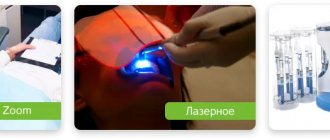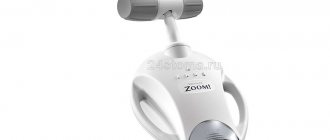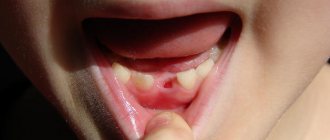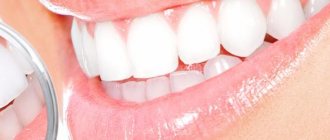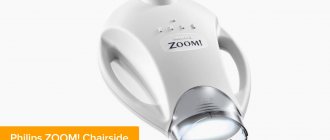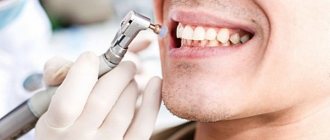In modern society, one correct and definitely useful trend has emerged - to pay close attention to the condition of your teeth. People strive to get the perfect Hollywood smile with straight white teeth, realizing that such a smile is not only an aesthetic appearance of the face, but also an opportunity to successfully build different relationships - personal and business. Teeth whitening is one of the services of modern dentistry that helps a person acquire an ideal smile.
For teeth whitening in a clinic (professional whitening), different technologies are used, and one of them is ZOOM 4. We will talk to you about the Zoom 4 teeth whitening method in this article: after reading the material, you will get acquainted with the features of Zoom 4, find out the indications and contraindications to this type of in-office whitening, the stages of whitening will also be discussed and a review will be provided in which Zoom 4 is compared with other methods of professional teeth whitening. We will not ignore the issue of price for the ZOOM 4 whitening service in Moscow.
What is Zoom-4
Whitening Zoom-4 is a cosmetic procedure for lightening tooth enamel by exposing it to chemical ingredients. The technique is an improved version of the Zoom-3 technology. Its advantage is a more gentle effect on the teeth (the top layer is not destroyed) and a reduced process time. The main active element that penetrates the enamel and discolors it is hydrogen peroxide, more precisely, one of its forms is carbamide peroxide. Standard concentration is 25%. It is safe and has no harmful effects on the body (when used externally).
During the procedure, the dentist uses a special lamp to activate a chemical reaction. This lamp has the option of regulating the light flow modes. The doctor can choose the optimal one for the conditions of a particular clinical case in order to increase the comfort of the process for the patient. Under the influence of radiation, atomic oxygen is released from hydrogen and penetrates the pores of tooth enamel, destroying pigment cells by an oxidative cleavage reaction.
Important: dentists recommend that patients with serious discoloration of teeth use not only clinical whitening, but also supplement it with home whitening. The doctor gives out a dental guard and chemical reagents in syringe tubes, and talks about the sequence of actions. The intensity of home manipulations is weaker, so the risk of accidental chemicals. burns are excluded if the given recommendations are followed.
The best teeth whitening system according to professionals
In terms of influence on a person’s attractiveness, hardly anything else can compare with a beautiful smile. A beautiful smile means, first of all, white teeth. However, white teeth do not mean healthy. Therefore, let’s try to figure out how to whiten teeth without harming their health, and which whitening system is better?
History knows that people have always been looking for a means to whiten their teeth.
The practice of teeth whitening dates back more than two thousand years. To obtain a more effective result, healers of the Slavic peoples, before bleaching, polished the surface layer of enamel with a metal file, after which they used a weak solution of nitric acid.
This technique was used until the end of the 18th century. Interest in issues of smile and dental aesthetics became especially evident at the beginning of the 19th century.
The most effective method of teeth whitening was the active element in which was chlorine, obtained from a solution of calcium hydrochloride and acetic acid.
I think it is obvious to everyone that such whitening methods caused irreparable damage to the teeth. But, as they say, “beauty requires sacrifice.”
Fortunately, in the modern world you can achieve beautiful teeth without damaging them.
Already by 1910, all teeth whitening techniques involved the use of hydrogen peroxide along with a heated instrument or light exposure. And in 1918, the principle of activating bleaching using thermal radiation was discovered.
High-intensity light radiation causes a rapid rise in temperature in the hydrogen peroxide solution, which leads to a rapid acceleration of the chemical processes of bleaching. This principle has been improved in many ways, but it still underlies modern teeth whitening systems.
In the 21st century, we can safely say that safe teeth whitening exists, but we will return to this later.
There are the following types of teeth whitening::
- home (carried out independently at home);
- office (clinical, performed by a dentist in a clinic)
In terms of the principle of action, home and office whitening are no different.
Whitening occurs by exposing the pigment inside the tooth to a whitening gel, usually containing hydrogen peroxide or carbamide peroxide.
Hydrogen peroxide and carbamide peroxide act as powerful oxidizing agents, breaking down into water, oxygen and free radicals (atomic oxygen). Hydrogen peroxide releases most of the reactive oxygen species within 30-60 minutes after use. Carbamide peroxide releases about 50% of the active substances in the first 2-4 hours, and the remaining 50% over the next 2-6 hours. The decomposition time is the main difference between these two substances.
The free radicals released affect the tooth pigment found in dentin. It has a yellow or gray color due to double carbon bonds. The pigment transfers this color to the teeth.
When atomic oxygen acts on pigment molecules of hydrogen peroxide or urea, the “colored” double bonds of the pigment are replaced by “colorless” single bonds. As a result, the tooth loses its yellow tint and becomes whiter. This is the mechanism underlying all modern whitening methods.
Please note: only your own teeth are whitened. Fillings, veneers, and crowns have a completely different structure, and whitening technologies do not work on them.
Contraindications to any type of whitening
There are a number of contraindications to the whitening procedure. Such as:
- the presence of allergic reactions to hydrogen peroxide or other components of bleaching systems;
- dental diseases (caries, gingivitis, periodontitis - first they need to be eliminated);
- pathological abrasion of teeth or deep cracks in the enamel;
- oncological diseases;
- some mental illnesses;
- taking a number of drugs that increase photosensitivity (antibiotics, systemic retinoids, etc.);
- pregnancy and breastfeeding;
- age up to 18 years, due to the characteristics of physiological processes.
If you enter a request for teeth whitening in the search bar, a huge number of means and methods will be offered.
I strongly recommend not to go back to the Middle Ages and not to use powders, coal, soda, acid and everything else. Take care of your teeth, and there are other uses for traditional methods. Among the products produced, you should choose only those that are certified, tested and proven in the market.
The best way to whiten is to visit a dentist! However, to understand, let’s take a closer look at the most current and popular methods of teeth whitening.
Home teeth whitening.
There is an opinion that you can whiten your teeth yourself. However, it is important to remember that before using any whitening systems you need to consult a specialist, since only a doctor can really assess the condition of the teeth and determine whether there are contraindications to the procedure. Uncontrolled use can cause quite a lot of damage to tooth enamel.
When whitening at home, various whitening strips, pencils and trays with gel are used. But whitening gels, strips and other products that are commercially available contain a small percentage of bleaching substances and have insignificant and short-lived whitening activity. They are applied to the surface of the teeth for the recommended time, and if necessary, the procedure is repeated several times to achieve the desired result.
All these types of home whitening have one main advantage - it is simplicity and ease of use, but it should be understood that, as a rule, whitening occurs by no more than 2-3 tones. And at the same time, they have a rather big drawback - their lack of control.
The least effective among this variety are pencils and strips. Some systems use universal mouthguards. However, they are intended for people with perfectly straight teeth, and in fact there are very few of them. Additionally, if you use an all-purpose tray or whitening strip for crowded teeth or other teeth alignment problems, there is an increased chance that the peroxide will penetrate the gums and cause a burn. Therefore, when choosing a system for home teeth whitening, it is better to give preference to professional ones, i.e. those in which individual mouthguards are used.
Custom mouthguards are custom-made based on an impression of the jaw and are suitable for repeated use. They accurately follow the shape of the teeth, which creates optimal contact between the whitening gel and the tooth surface. Thanks to this, the likelihood of the gel penetrating the mucous membrane of the gums and oral cavity is reduced, which reduces the risk of gum burns. The patient uses it and low concentration whitening gel independently. The length of time you wear the aligner depends on the concentration of the bleaching agent, as well as the desired result.
The remedy is selected by the doctor based on the patient’s unique situation – natural tooth sensitivity, the presence of gum disease, the quality of hard tissues, etc.
The effect of home whitening lasts for a long time. Depending on the stability of the color, the dentist may recommend short-term maintenance courses once every six months.
Mouthguards can be worn both during the day and at night. The first signs of color change appear on the fourth or fifth day and gradually intensify towards the end of the course. The use of individual trays is the basis for the operation of full-fledged Philips Zoom home whitening systems: DayWhite and NiteWhite, as well as Opalescence PF gels.
We can talk about the harmful effects of home whitening systems if the patient violates the recommendations and indications. For example, an excessive amount of gel in a mouth guard will lead to its squeezing out when applied to the teeth: the gel will get on the gums, and, as a result, there may be a burn to the mucous membrane. Or the patient, in an effort to enhance the whitening effect, wears aligners longer than prescribed.
It is always necessary to strictly follow the recommendations. It should be remembered that patients with increased tooth sensitivity will experience a sharp increase in sensitivity during whitening. Using home whitening as a primary method only makes sense when the patient initially has light-colored teeth. In the case of yellow teeth, the effect will be minimal, almost zero.
Features of home whitening:
- home whitening takes longer - from 2 weeks to several months of regular use;
- the concentration of the gel in the case of home lightening is 2-3 times lower than during office procedures;
- home whitening involves applying the gel yourself, putting on a tray and then removing any remaining active substance, all on a regular basis.
I recommend home whitening in two cases::
- as a fixative in complex professional whitening;
- as maintenance 4-6 months after in-office whitening.
To ensure that the whitening procedure proceeds without harm to your health, I strongly advise you to resort to professional whitening methods, which are carried out under the supervision of a dentist.
What is the best teeth whitening?
According to dentists, the whitening system is evaluated according to the following criteria: safety, effectiveness and speed of implementation. In order to understand which whitening is the best, let's compare all the pros and cons of various in-office whitening techniques. If efficiency is taken as the main evaluation criterion, then in-office whitening (any of them) is superior to home whitening.
Professional (clinical) teeth whitening
All clinical teeth whitening procedures work on the same principle: whitening occurs due to a gel applied to the surface of the teeth, the main component of which is hydrogen peroxide.
There are four types of professional in-office whitening:
- chemical whitening (the doctor applies a gel to the teeth);
- Thermal photobleaching (gel is applied and it is activated by a lamp with warm light that heats it);
- Cold light photobleaching (the gel is activated by cold diode light, without heating);
- laser (gel is activated by a laser beam).
Note: activation is the process of accelerating the chemical reaction of a gel due to external influences: light, temperature, another reagent.
Chemical bleaching method.
In chemical bleaching, the gel is activated by mixing with a chemical catalyst and does not require the use of an external catalyst,
This is the simplest and most inexpensive procedure that allows you to achieve a lighter shade of teeth than was intended by nature.
the Opalescence Boost (Xtra) whitening system . This is a highly concentrated gel with 35 percent hydrogen peroxide.
The principle of operation is simple: the activated gel is applied to the teeth, washed off after a certain period of time, and the procedure is repeated, the result obtained can be called good.
Teeth are brightened by 5-10 shades in one session. Bleaching is practically harmless, since there is absolutely no risk of pulp overheating.
So what's the downside? The disadvantage is that to achieve a good result it is necessary to use a high concentration of gel and carry out a longer exposure, which contributes to drying of the teeth and an increase in the period of sensitivity after the procedure.
But there are also advantages - the absence of overheating of the teeth, availability and price. Therefore, teeth whitening with the Opalescense system still retains its position today.
Photo whitening (activation with warm light)
WhiteSpeed Professional Philips Zoom is a world-famous technology and professional teeth whitening system. This whitening system was invented in the USA. The essence of the technique is as follows: a special whitening gel is used, which is activated under the influence of ultraviolet radiation. At first, this technique had serious drawbacks. However, the system was gradually improved and became more and more secure.
Zoom3 has already boldly conquered the world, achieving the title safe and effective.
This method of whitening uses a lamp with ultraviolet radiation, which activates the whitening gel to more intensively penetrate the peroxide into the dentin and achieve a more powerful effect.
Ultraviolet light affects the whitening gel, containing up to 35% hydrogen peroxide, and activates the oxidizing agents contained in it, while the tooth surface can heat up , and accordingly, after the procedure, tooth sensitivity can increase significantly.
The advantages of this method of whitening: teeth are whitened up to 8-10 shades, the result will be obtained in one session; the procedure is practically harmless.
The disadvantages are the same as in the case of chemical whitening: the period of tooth sensitivity intensifies and increases, only in the case of zoom3 due to overheating of the teeth. This system already contains a gel to relieve this unpleasant symptom.
Availability and price advantages keep ZOOM3 strong. This whitening method is successfully performed by dentists and is in demand among patients.
However, answering the question: “the best whitening system according to professionals,” I rarely discuss these types of whitening with my patients, due to the emergence of more innovative methods.
If for some reason innovations are not available, then do not worry, the considered methods will still be better than long-term uncontrolled home whitening.
If an experienced doctor takes on the job, the result will be 100% and without negative consequences or discomfort.
Advanced technology – maximum efficiency
Photobleaching (cold light activation)
LED, or cold light, is a modern option for activating the whitening gel. LED lamps do not heat the surface of the tooth and do not dry it out. This minimizes the risk of sensitivity and significantly improves tolerability of the procedure.
It is the LED light source that is equipped with the whitening lamp of the Philipszoom4 generation system . Because it emits LED light, this system is called cold whitening. ZOOM 4 is the latest generation of photo teeth whitening with the most gentle treatment of teeth and high efficiency!
Therefore, the gel contains a reduced concentration of hydrogen peroxide (about 25%), the activity of which is triggered after exposure to light, while the efficiency is quite high, so the exposure time on the teeth is much shorter than previous systems.
The second component is alkaline, the function of which is to neutralize the resulting acid and prevent the destruction of enamel.
The final stage: treatment of teeth with Relief remineralizing gel containing amorphous calcium phosphate, which enriches the enamel with calcium, fills the dentinal tubules and saturates the hard tissues of the teeth with minerals. This gel restores enamel and reduces overall tooth sensitivity.
The entire procedure is painless and psychologically comfortable. The results of Zoom whitening are long-lasting and depend on following the recommendations. The only downside is the cost of the procedure.
Advantages:
- In one session, you can change the color of the enamel up to 8-12 shades in one procedure
- ZOOM 4 is equipped with a cold LED light source, which eliminates overheating of the deep layers of the tooth and gums;
- suitable for patients with tooth sensitivity;
- ZOOM 4 technology does not thin or damage the enamel;
- significant reduction in exposure time to the teeth and therefore the entire procedure
- the result lasts up to 3 years;
Laser whitening Dr. Smile
Laser teeth whitening is a method of professional teeth whitening, which is based on the use of a laser in combination with a special gel.
The gel contains 30% hydrogen peroxide and a catalyst for the laser beam. The gel collects the laser light and breaks down into particles that whiten tooth enamel.
It is enough to apply a laser to a tooth coated with a whitening composition for one to two minutes to achieve a good effect, even in the most difficult cases. There is an opinion that the effect of laser whitening is more pronounced due to the ability of the laser itself to break down pigments.
Another obvious advantage of the technique is a more controlled bleaching process, which significantly reduces the risk of pulp overheating and other possible complications.
Device Dr. Smile is a computerized system with integrated software for any procedure. The computer has programs for any procedure with clinical information and parameters. Therefore, this teeth whitening is safe and meets the protocol requirements.
At the final stage, the teeth are covered with a gel (to reduce sensitivity), which is also activated by a laser.
Today, we can say that laser teeth whitening is a method that does not damage tooth enamel and which gives long-term, stable results.
Among the disadvantages of laser whitening, one can only mention its high cost.
Advantages of laser whitening:
- The laser whitening procedure is indicated for people with high sensitivity, because there is no heating of the tooth tissue;
- all types of pigment formations are eliminated;
- you can lighten your teeth by 8-12 shades in one session;
- when exposed to laser, tooth enamel is not damaged;
- laser radiation has bactericidal properties;
- it is possible to carefully control the process, selecting the intensity and duration of exposure;
- reducing the time of exposure to teeth and therefore the procedure as a whole;
- the result lasts for a long time – up to 3 years.
Despite the fact that the impact parameters can be selected extremely accurately, the result is individual. If after the first session it was not possible to achieve the desired result, the procedure can be repeated. Its impeccable results last for several years. However, everything here is also quite individual. So, the effect will last for as long as possible if you adhere to a number of rules:
- you should stop eating foods with dyes (or at least limit their use);
- It is recommended to completely stop smoking;
- For daily oral hygiene, you should use professional toothpastes that provide a slight whitening effect;
- it is necessary to use high-quality toothbrushes or even replace them with a irrigator;
- It is recommended to have your teeth professionally cleaned every six months.
Your teeth will always be whiter than before the laser whitening procedure, since the color does not return to the original shade.
Effective whitening system
When choosing a teeth whitening technique, first of all, the doctor relies on medical indications and contraindications to the procedure, as well as the individual characteristics and wishes of the patient.
All professional methods allow you to achieve significant and lasting results. Our dental clinic uses the latest equipment and the best drugs for teeth whitening.
To decide on choosing a whitening method, you need to make an appointment with a doctor. After a thorough examination of your teeth and mouth, your doctor will suggest the most suitable teeth whitening plan for you and agree on the cost of treatment.
Professional teeth whitening is a safe, effective procedure.
Modern whitening systems cope perfectly with the problem of yellow teeth, allowing you to achieve a significant and long-lasting whitening effect.
The most effective are laser whitening and photo whitening with cold light. In combination with a maintenance course of home whitening using individual trays, they give excellent results.
The effectiveness and quality of modern whitening systems have been time-tested and are safe when used correctly and in consultation with a doctor.
Indications and contraindications of the method
The procedure is used to whiten the enamel by several tones. This may be required in several cases:
- if desired, add additional whiteness to your smile;
- with the formation of pigmented plaque from smoking;
- with pigmentation from taking tetracycline antibiotics;
- after a course of orthodontic correction with braces.
Despite its safety, lightening the enamel surface of the teeth using the ZOOM-4 method cannot always be carried out. The following prohibitions exist:
- children's age (up to 16 years);
- pregnancy and breastfeeding;
- oncology;
- dental diseases;
- periodontal disease in the acute stage;
- exposure of the roots of dental elements;
- a course of antibiotics and regular use of oral contraceptive pills;
- mental illnesses;
- allergy to the components of the chemical complex.
Before the procedure, the dentist conducts a visual examination and collects anamnesis regarding existing contraindications. After analyzing the list above, we can conclude that some prohibitions are temporary. So, if you have problems with your teeth, it is enough to eliminate them. Then you can perform bleaching. The same applies to a course of antibacterial therapy or taking contraceptives. If there are absolute contraindications, the patient will have to abandon the idea of chemical lightening. But don’t be upset, the enamel can be lightened a couple of tones using the Air Flow hardware cleansing method.
.
How often can the procedure be done?
It has been experimentally proven that the whitening effect lasts up to 5 years. But some patients, striving for perfection of their appearance, would like to do this procedure more often. Doctors advise taking your time and allowing tooth enamel to recover after chemical exposure. The recovery period takes about 2 years. Therefore, you should go to the clinic for a new portion of “snow-white radiance” no more than once every two years. If you perform the manipulation more often, you can deplete the enamel layer, making it overly sensitive and susceptible to the penetration of pathogenic microflora. And this significantly increases the likelihood of developing caries and other dental problems.
Advantages and disadvantages of Zoom-4
Advantages of Zoom-4 whitening:
- Efficiency (8 tones in 45 minutes (excluding preparation))
- No anesthesia required
- Long-term effect (up to 5 years)
- Gentle on enamel
- High efficiency (even with fluorosis)
- No risk of gum burns
Minuses:
- Many contraindications
- Possibility of increasing tooth sensitivity in people with a vulnerable enamel layer
- Impossibility of giving whiteness to old fillings and dentures
- High price
Classification
In addition to the classic version of ZOOM, there are others:
- ZOOM-2;
- ZOOM-3;
- ZOOM-4.
These are updated versions. In fact, they are all equally effective. The final result and how long the effect lasts depend more on the initial state of the hard tissues of the oral cavity, the individual characteristics of the patient’s body and his or her eating habits.
Among the features that you need to pay attention to when choosing a whitening method:
- Zoom-2 has a longer wavelength than the classic ZUUM. This allows you to lighten your teeth to the desired tone in a shorter period of time.
- When using third and fourth generation systems, only original dental reagents and instruments are allowed. This improves the quality of the service provided. At the same time, the peroxide content in the whitening gel for options 3 and 4 is much lower - 25% (for the first and second versions - approximately 35%). This makes the procedure as safe as possible.
Thus, ZOOM 3rd and 4th generations still have advantages - they make it possible to spend less time in the dentist’s chair and are safe for enamel. But treatment with these versions is more expensive.
Procedure algorithm
The bleaching process consists of several sequential stages:
- visual inspection, identification of possible contraindications, determination of the tone of the planned result according to the Vitta color scale;
- applying a special composition to the surface of the oral mucosa that will protect the tissues from an aggressive chemical environment;
- putting on safety glasses;
- treatment of teeth with a disinfectant composition and subsequent drying;
- Covering the tooth surface with whitening gel and exposing it to a Philips Zoom emitter lamp for 15 minutes. This stage is repeated up to 3 times if necessary;
- application of a composition for remineralization to the enamel.
Expert's comment: The process uses chemicals and ultraviolet radiation, so this procedure can only be performed in a dental clinic and must be carried out by a qualified doctor. Otherwise, it may result in harm to health.
Dentist advice
Experts recommend:
- do not be afraid of possible pain. 99% of all people who have undergone this procedure did not feel pain;
- A prerequisite for ensuring a uniform whitening effect is preliminary professional dental cleaning. Otherwise, areas with plaque or tartar will be much darker than the rest of the surface;
- after a visit to the clinic, you should not smoke for 3 days, you should not drink strong tea and coffee for a week, or consume foods and drinks containing natural or artificial dyes;
- During the first two weeks, the mouth must be cleaned after each meal and at night. In this case, in addition to the usual brush and paste, you should use an irrigator (a device for cleaning teeth with a directed stream of water under pressure);
- At the first symptoms of dental problems, consult a doctor.
The network of dental clinics “Smile” offers teeth whitening services using the ZOOM-4 method. We have family and cumulative discounts. Our doctors are highly qualified and continue to improve their skills in leading Russian and European dental clinics. The level of medical services provided in our centers meets international standards.
Branches of our orthodontic center are located in Moscow within walking distance from the metro:
- Art. Alekseevskaya (VDNKh district, etc. Mira), address: st. 3rd Mytishchiskaya house 3, building 2;
- Art. Shelepikha, address: Shelepikhinskaya embankment, address: building 34, building 1.
We will make your smile snow-white! Come to us for beauty and health!
Do it yourself or dentistry at home
It would seem that it has long been clear that procedures related to one’s own health are best left to professionals. After all, in the end, going to a doctor will be the most economical way both in terms of time and costs. Self-medication, at a minimum, does not lead to the desired results, and in the worst case scenario, it creates new problems, the elimination of which will require both time and money.
To whiten teeth at home, specialized toothpastes are used, as well as whitening strips and pencils. However, in most cases, the effect of use is minimal or absent altogether. The reasons for this lie in the fact that the recommendations for the use of these products specified in the accompanying manuals do not take into account many factors - such as age, dental condition, the presence of dental defects or chronic diseases, as well as inflammatory processes. Not to mention that many people prefer not to read any instructions at all. The result can be disastrous - without solving one problem, you will acquire new ones in the form of specific complications.
Even if you carefully follow all the instructions, avoid products that promise a miracle effect in just a day or hour. Such technologies simply do not exist! The trick of some unscrupulous manufacturers may come down to the inclusion of a dye in the composition. As a result, your teeth will actually turn white for a short time, but after the first brushing or a couple of meals, all the whiteness will quickly disappear.
In a situation where the problem is not so significant, the most reasonable action would be to consult a dentist, who will be able to prescribe medications for home use in accordance with an individually developed program. In more complex cases, whitening should be done in the dentist's office.




